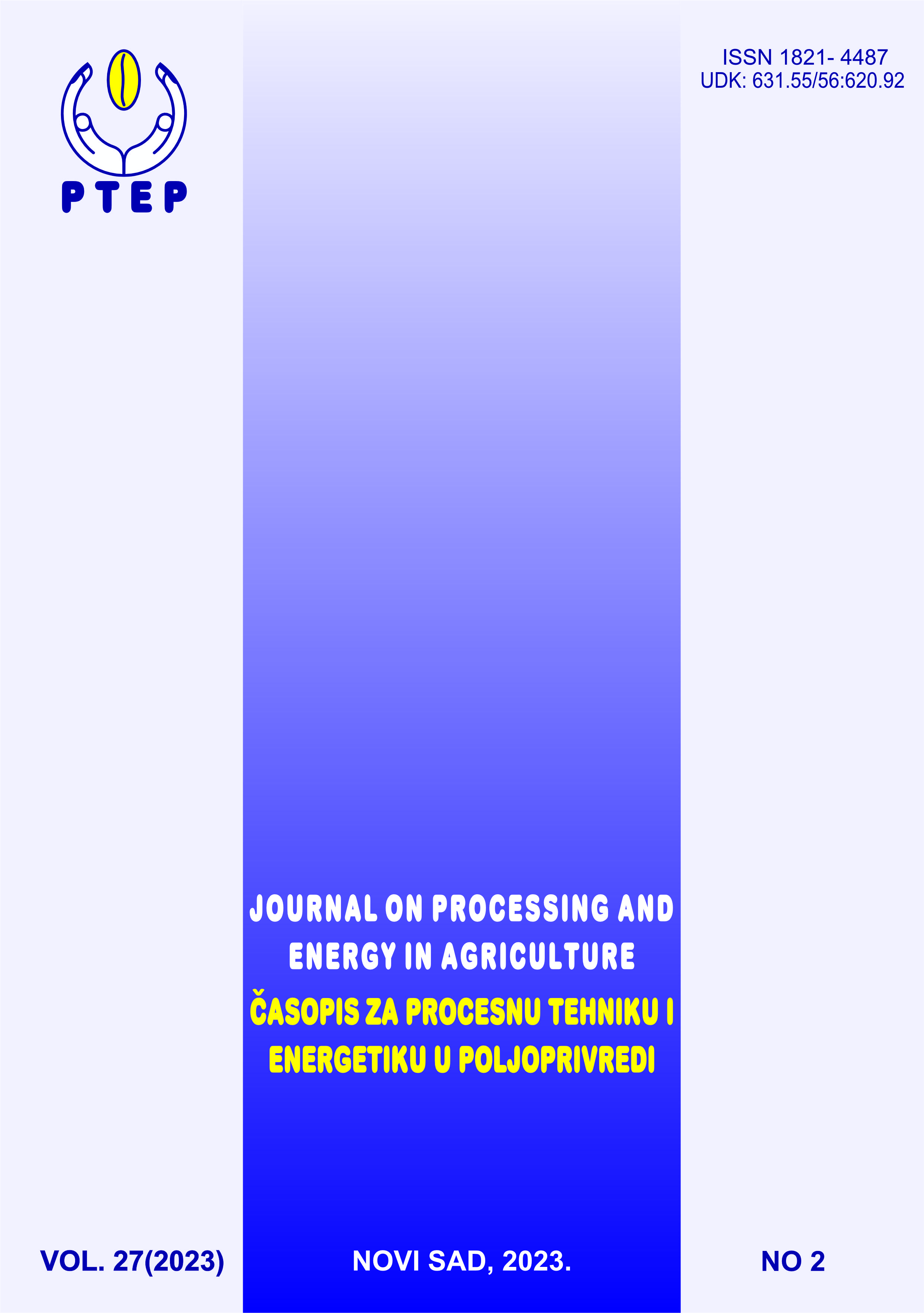The COMPREHENSIVE REVIEW ON BIOMASS POTENTIAL FOR AGRICULTURAL BIOGAS PRODUCTION IN SRI LANKA
Abstract
Biogas emerges as a renewable energy option that offers a wide range of advantages. This study assesses the appropriateness of a range of biomass feedstock choices, encompassing energy crops, bio-waste, materials derived from both animals and plants, as well as organic residues produced within the food production sector. The aim is to determine their potential as viable substrates for agricultural biogas plants in Sri Lanka. Nevertheless, administrative obstacles and inefficiencies within the existing facilities impede the complete utilization of this potential. In parallel, it is of paramount importance to develop and enhance cost-effective technologies for converting agricultural biomass into energy, all while avoiding conflicts with the food and animal feed industries. Consideration should be given to judiciously utilizing disputed resources like fresh fruits and vegetables as raw materials. When employing biomass for energy generation, factors like economic viability, resource availability, and storage need to be meticulously assessed. Additionally, this review proposes that conducting a life cycle assessment within Sri Lanka's energy sector is both feasible and essential for comparing the energy potential of biomass-based sources with conventional fossil fuels. Such an evaluation can offer invaluable insights into sustainable energy choices for the nation's future.
References
Abbasi, T., et al. (2012), Biogas Energy. Springer New York, New York.
Adib, R., et al. (2015). Renewables 2015 Global Status Report; REN21 Secretariat: Paris, France.
Alwis, A.D., (2002), Biogas - a review of Sri Lanka’s performance with a renewable energy technology, Energy for Sustainable Development, 1(1), 30-36. https://doi.org/ 10.1016/S0973-0826(08)60296-3
Ang T.Z., et al. (2022). A comprehensive study of renewable energy sources: Classifications, challenges and suggestions, Energy Strategy Reviews, 43, 2-3. https://doi.org/10.1016/j.esr.2022.100939.
Arachchige, U.S.P.R. et al. (2019). Proposed model for solid waste management in Sri Lanka. International Journal of Scientific & Technology Research, 8 (12), 1544-1548.
Asian Development Bank Website (accessed on 13th May 2023).https://www.adb.org/publications/electricity-generation-renewable-energy-2050-sri-lanka
CGIAR Website (accessed on 15thJuly 2023). https://www.cgiar.org/
Chathumini, K.K.G.L et al. (2021), Agriculture and Greenhouse Gas Emissions, Journal of research technology and engineering, 2 (2), 22-30.
Department of Animal Production and Health – Sri Lanka Website (accessed on 17th May 2023) https://www.daph.gov.lk
Garg, H. P., & Datta, G. (1998). Global status on renewable energy. In Solar energy heating and cooling methods in building, international workshop: Iran University of Science and Technology, 24(1-2),19-20. https://doi.org/10.1260/014459806779388065
Haase, R. (1971). Thermodynamics of Irreversible Processes(Addison-Wesley Series in Chemical Engineering), Addison Wesley Publishing Co., Boston, MA, USA
Help O –Sri Lanka Website (accessed 2nd July 2023). https:// www.helpo- srilanka.org.
International Energy Agency website (accessed on 22nd June 2023) .https://www.iea.org/reports/world-energy-investment-2023
International Water Management Institute website (accessed on 27th May 2023).
http://waterdata.iwmi.org/Applications/sanitaion/reports/Report%20Institutions_First%20
Jambeck, J.R. et al (2015), Plastic waste inputs from land into the ocean. Science 2015, 347 (6223),768–771. https://doi.org/10.1126/science.1260352
Jędrejek, A.& Jarosz, Z.(2016) Regionalne możliwości produkcji biogazu rolniczego (Regional possibilities of agricultural biogas production). Rocz. Nauk. Stowarzyszenia Ekon. Rol. Agrobiz. 2016 (18), 61–65. http://dx.doi.org/10.22004/ag.econ.257637
Kalak, T., (2023). Potential Use of Industrial Biomass Waste as a Sustainable Energy Source in the Future. Energies, 16 (4): 1783. https://doi.org/10.3390/en16041783.
Klass, D.L., (1998) Biomass for renewable energy, fuels, and chemicals. Academic Press, Salt Lake City, UT, USA
Kumaradasa, M.A., (1999). Study of biomass as a source of energy in Sri Lanka, RERIC International Energy Journal, 21 (1), 55-67.
Lokuliyana, R.L.K., Ambawatte, C., & Kumara, W.V.D.L., (2016), Feasibility Study on Anaerobic Bio Gas Plants in Sri Lanka, SLEMA Journal, 19(1), 1-6, https://doi.org/ 10.4038/slemaj.v19i1.12
M. Balat, M & Ayar. G (2005) Biomass Energy in the World, Use of Biomass and Potential Trends, Energy Sources, 27(10), 931-940, https://doi.org/ 10.1080/00908310490449045.
Muhamad M.I.et al.(2023). Shaping Sustainability Through Power Engineering Innovation, proceedings of Third International Conference in Power Engineering Applications – IEEE 2023. 06-07. March 2023. Putrajaya, Malaysia .
Our World in Data website (accessed on 28th June 2023), https://ourworldindata.org/energy
Piwowar, A.; Dziku´c, A.& Adamczyk, J.(2016). Agricultural biogas plants in Poland—Selected technological, market and environmental aspects. Renewable Sustainable Energy Reviews, 58, 69–74.
Raja, I.A.(2021). Agriculture Residue: A Potential Source for Biogas Production. Annals of Agricultural and Crop Sciences, 6 (3), 2-3.
Reitemeier, M., Aheeyar, M. & Drechsel, P.(2021). Perceptions of food waste reduction in Sri Lanka’s commercial capital, Colombo. Sustainability,13 (2), 838 .https://doi.org/10.3390/su13020838
Rodriguez, A.; Latawiec, A.E. (2018), Rethinking Organic Residues: The Potential of Biomass in Brazil. Modern Concepts and Developments in Agronomy, 1(4),73-77. https://doi.org/10.31031/MCDA.2018.01.000519.
Sikora, J. & Tomal, A. (2016). Determination of the energy potential of biogas in selected farm household. Infrastructure and .Ecology of Rural Areas, 3, 971–982.
Sri Lanka Sustainable Energy Authority Website (15th August 2023) https://www.energy.gov.lk/index.php/en/
Suocheng, D.; Tong, K.W. & Yuping, W. (2011). Municipal solid waste management in China: Using commercial management to solve a growing problem. Utilities Policy, 10 (1), 7–11.
Surmen, Y. 2002. The necessity of biomass energy for Turkish economy. Energy Education Science and Technology, 10,19–26. http://dx.doi.org/10.1080/00908310390142145
The United Nations website (accessed on 26th July 2023). https://www.un.org/development/desa/en/news/population/world-population-prospects-2019.html.
The worldometer website (accessed on 12th June 2023). https://www.worldometers.info/
Trading Economics Website (accessed on 02nd August 2023) https://tradingeconomics.com/sri-lanka/gdp-growth-annual
United state environmental protection Agency Website (accessed on 05th July 2023).https://www.epa.gov/hw/criteria-definition-solid-waste-and-solid-and-hazardous-waste-exclusions
World Bioenergy Association Website (accessed on 17th July 2023). https://www.worldbioenergy.org/
Yan, Y., et al. (2019), Identification of parameters needed for optimal anaerobic co-digestion of chicken manure and corn stover, RSC Advances, 9(51), 29609–29618.

